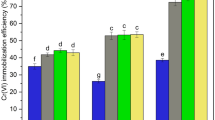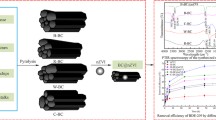Abstract
Purpose
Soil contamination and solid waste accumulation pose significant risks to the safety of agricultural produce and residential areas. In China, coal gangue, a typical form of solid waste, is rich in valuable elements like silicon and aluminum, making it an ideal precursor for the synthesis of zeolite molecular sieves. This study focuses on transforming coal gangue into iron-enhanced X-type zeolite (Fe-NaX) molecular sieve and explores its potential in remediating lead (Pb) and cadmium (Cd) co-contaminated soil.
Methods
Fe-NaX was synthesized from coal gangue in Sichuan using an alkaline melting hydrothermal method. In order to evaluate the effectiveness of Fe-NaX in remediation and assess its ecological risk, soil culture and acid rain leaching experiments were conducted. The microstructures of Fe-NaX were detected to explore its remediation mechanism.
Results
The optimal Fe-NaX was synthesized at a 110 °C hydrothermal reaction temperature, a 1.5 mass ratio of NaOH and pretreated coal gangue (PCG), a 2.0 Si/Al molar ratio, and a 3.5 M alkalinity. Fe-NaX demonstrated outstanding performance in remediating Pb and Cd contaminated soil, with immobilizing efficiency for high bioavailability fractions of Pb and Cd at 44.4% and 21.9%, respectively. Even under acid rain stress, Fe-NaX was able to decrease the release of Pb and Cd in the soil by 42.3% and 59.6% respectively, with minimal ecological risk.
Conclusion
This study, based on a “solid waste for soil-remediation” strategy, transforms coal gangue into Fe-NaX for use in soil remediation and holds great promise for the contaminated soil remediation and coal gangue comprehensive utilization.
Graphical abstract








Similar content being viewed by others
Data availability
The datasets generated and/or analyzed during the current study are available from the corresponding author on reasonable request. Raw data were collected under environmental conditions that do not require ethical approval or legal restrictions on sharing. Additional derived data supporting the findings of this study are available from the corresponding author, Jiang Yu, at yjuj@scu.edu.cn, upon reasonable request.
References
Boostani HR, Hardie AG, Najafi-Ghiri M, Khalili D (2017) Investigation of cadmium immobilization in a contaminated calcareous soil as influenced by biochars and natural zeolite application. Int J Environ Sci Technol 15:2433–2446. https://doi.org/10.1007/s13762-017-1544-3
Chandrasekhar S, Pramada PN (1999) Investigation on the synthesis of zeolite NaX from kerala kaolin. J Porous Mater 6:283–297. https://doi.org/10.1023/a:1009632606671
Chen J, Lu X (2017) Synthesis and characterization of zeolites NaA and NaX from coal gangue. J Mater Cycles Waste Manage 20:489–495. https://doi.org/10.1007/s10163-017-0605-5
Contin M, Miho L, Pellegrini E, Gjoka F, Shkurta E (2019) Effects of natural zeolites on ryegrass growth and bioavailability of Cd, Ni, Pb, and Zn in an Albanian contaminated soil. J Soils Sediments 19:4052–4062. https://doi.org/10.1007/s11368-019-02359-7
Deng S, Yu J, Wang Y, Xie S, Ran Z, Wei W (2019) Distribution, transfer, and time-dependent variation of Cd in soil-rice system: a case study in the Chengdu plain. Soil and Tillage Research, Southwest China. https://doi.org/10.1016/j.still.2019.104367
Dhaliwal SS, Singh J, Taneja PK, Mandal A (2020) Remediation techniques for removal of heavy metals from the soil contaminated through different sources: a review. Environ Sci Pollut Res Int 27:1319–1333. https://doi.org/10.1007/s11356-019-06967-1
Gao H, Liu J, Song H, Yang J, Mou H, Fan H (2021) Research on brightening modification of molecular sieves coated fly ash based on alkaline melting hydrothermal method. Nord Pulp Pap Res J 36:512–522. https://doi.org/10.1515/npprj-2021-0007
Guan J, Lu M, Yao X, Wang Q, Wang D, Yang B, Liu H (2021) An Experimental Study of the Road Performance of Cement Stabilized Coal Gangue. Crystals. https://doi.org/10.3390/cryst11080993
He Y, Fang T, Wang J, Liu X, Yan Z, Lin H, Li F, Guo G (2022) Insight into the stabilization mechanism and long-term effect on As, Cd, and Pb in soil using zeolite-supported nanoscale zero-valent iron. J Clean Prod. https://doi.org/10.1016/j.jclepro.2022.131634
Hu Q, Zeng W-a, Li F, Huang Y, Gu S, Cai H, Zeng M, Li Q, Tan L (2018) Effect of nano zeolite on the transformation of cadmium speciation and its uptake by tobacco in cadmium-contaminated soil. Open Chem 16:667–673. https://doi.org/10.1515/chem-2018-0069
Kim RY, Yoon JK, Kim TS, Yang JE, Owens G, Kim KR (2015) Bioavailability of heavy metals in soils: definitions and practical implementation—a critical review. Environ Geochem Health 37:1041–1061. https://doi.org/10.1007/s10653-015-9695-y
Li J, Wang J (2019) Comprehensive utilization and environmental risks of coal gangue: a review. J Clean Prod. https://doi.org/10.1016/j.jclepro.2019.117946
Li P, Yu J, Huangfu Z, Chang J, Zhong C, Ding P (2020) Applying modified biochar with nZVI/nFe(3)O(4) to immobilize Pb in contaminated soil. Environ Sci Pollut Res Int 27:24495–24506. https://doi.org/10.1007/s11356-020-08458-0
Li Z, Wang L, Meng J, Liu X, Xu J, Wang F, Brookes P (2018) Zeolite-supported nanoscale zero-valent iron: new findings on simultaneous adsorption of Cd(II), Pb(II), and As(III) in aqueous solution and soil. J Hazard Mater 344:1–11. https://doi.org/10.1016/j.jhazmat.2017.09.036
Ltaief OO, Siffert S, Fourmentin S, Benzina M (2015) Synthesis of Faujasite type zeolite from low grade Tunisian clay for the removal of heavy metals from aqueous waste by batch process: kinetic and equilibrium study. C R Chim 18:1123–1133. https://doi.org/10.1016/j.crci.2015.03.013
Ma X, Zuo H, Tian M, Zhang L, Meng J, Zhou X, Min N, Chang X, Liu Y (2016) Assessment of heavy metals contamination in sediments from three adjacent regions of the Yellow River using metal chemical fractions and multivariate analysis techniques. Chemosphere 144:264–272. https://doi.org/10.1016/j.chemosphere.2015.08.026
Ministry of Agriculture and Rural Affairs (2006) Soil testing. Part 6: method for determination of soil organic matter (NY/T 1121.6-2006). Beijing, China
Ministry of Agriculture and Rural Affairs of the People`s Republic (2007) Determination of pH in soil (NY/T1377-2007). Beijing, China
Ojha K, Pradhan NC, Samanta AN (2004) Zeolite from fly ash: synthesis and characterization. Bull Mater Sci 27:555–564. https://doi.org/10.1007/bf02707285
Oste LA, Lexmond TM, Van Riemsdijk WH (2002) Metal immobilization in soils using synthetic zeolites. J Environ Qual 31:813–821. https://doi.org/10.2134/jeq2002.8130
Pallarés J, Herce C, Bartolomé C, Peña B (2017) Investigation on co-firing of coal mine waste residues in pulverized coal combustion systems. Energy 140:58–68. https://doi.org/10.1016/j.energy.2017.07.174
Prakash J, Agrawal SB, Agrawal M (2023) Global trends of acidity in rainfall and its impact on plants and soil. J Soil Sci Plant Nutr 23:398–419. https://doi.org/10.1007/s42729-022-01051-z
Qin L, Gao X, Su A, Li Q (2021) Effect of carbonation curing on sulfate resistance of cement-coal gangue paste. J Clean Prod. https://doi.org/10.1016/j.jclepro.2020.123897
Rozhkovskaya A, Rajapakse J, Millar GJ (2021) Optimisation of zeolite LTA synthesis from alum sludge and the influence of the sludge source. J Environ Sci (china) 99:130–142. https://doi.org/10.1016/j.jes.2020.06.019
Shao N, Tang S, Li S, Chen H, Zhang Z (2020) Defective analcime/geopolymer composite membrane derived from fly ash for ultrafast and highly efficient filtration of organic pollutants. J Hazard Mater 388:121736. https://doi.org/10.1016/j.jhazmat.2019.121736
Shi J, Du P, Luo H, Chen J, Zhang Y, Wu M, Xu G (2021) Characteristics and risk assessment of soil polluted by lead around various metal mines in China. Int J Environ Res Public Health. https://doi.org/10.3390/ijerph18094598
Shigemoto N, Sugiyama S, Hayashi H, Miyaura K (2004) Characterization of Na-X, Na-A, and coal fly ash zeolites and their amorphous precursors by IR, MAS NMR and XPS. J Mater Sci 30:5777–5783. https://doi.org/10.1007/bf00356720
Szerement J, Szatanik-Kloc A, Jarosz R, Bajda T, Mierzwa-Hersztek M (2021) Contemporary applications of natural and synthetic zeolites from fly ash in agriculture and environmental protection. J Clean Prod. https://doi.org/10.1016/j.jclepro.2021.127461
State Administration for Market Regulation (2009) Soil quality—analysis of available lead and cadmium contents in soils—atomic absorption spectrometry (GB/T 23739-2009). Beijing, China
State Administration for Market Regulation (2018) Determination of ignition loss in coal gangue (GB/T 35986-2018). Beijing, China
Xiao J, Zhang L, Yuan J, Yao Z, Tang L, Wang Z, Zhang Z (2018) Co-utilization of spent pot-lining and coal gangue by hydrothermal acid-leaching method to prepare silicon carbide powder. J Clean Prod 204:848–860. https://doi.org/10.1016/j.jclepro.2018.08.331
Zeng F, Ali S, Zhang H, Ouyang Y, Qiu B, Wu F, Zhang G (2011) The influence of pH and organic matter content in paddy soil on heavy metal availability and their uptake by rice plants. Environ Pollut 159:84–91. https://doi.org/10.1016/j.envpol.2010.09.019
Zhan H, Jiang Y, Yuan J, Hu X, Nartey OD, Wang B (2014) Trace metal pollution in soil and wild plants from lead–zinc smelting areas in Huixian County, Northwest China. J Geochem Explor 147:182–188. https://doi.org/10.1016/j.gexplo.2014.10.007
Zhao FJ, Ma Y, Zhu YG, Tang Z, McGrath SP (2015) Soil contamination in China: current status and mitigation strategies. Environ Sci Technol 49:750–759. https://doi.org/10.1021/es5047099
Zhao H, Zhang J, Wu F, Huang X, Liu F, Wang L, Zhao X, Hu X, Gao P, Tang B, Ji P (2022) A 3-year field study on lead immobilisation in paddy soil by a novel active silicate amendment. Environ Pollut 292:118325. https://doi.org/10.1016/j.envpol.2021.118325
Zheng R, Feng X, Zou W, Wang R, Yang D, Wei W, Li S, Chen H (2021) Converting loess into zeolite for heavy metal polluted soil remediation based on “soil for soil-remediation” strategy. J Hazard Mater 412:125199. https://doi.org/10.1016/j.jhazmat.2021.125199
Funding
The research was supported by the grants including the National Key Research and Development Program (No. 2018YFC1802605), the Sichuan Regional Innovation Cooperation Project (No. 2022YFQ0081), the Chengdu Key R&D Support Plan Project (No. 2022-YF05-00357-SN), and the Sichuan University-Yibin City School and City Strategic Cooperation Project (No. 2020CDYB-9).
Author information
Authors and Affiliations
Corresponding author
Ethics declarations
Intellectual property
The authors hereby declare that the publication of this manuscript will not affect any patents, trademarks, or copyrights. All data and materials used in this study are either owned by the authors or have been used under appropriate licenses or permissions. Additionally, this manuscript is completely original, has not been published elsewhere in any form or medium, and is not currently under consideration for publication by any other publishing entity.
Conflict of interest
The authors declare no competing interests.
Additional information
Responsible editor: Claudio Bini
Publisher's Note
Springer Nature remains neutral with regard to jurisdictional claims in published maps and institutional affiliations.
Highlights
• Iron-enhanced X-type zeolite (Fe-NaX) was successfully synthesized using coal gangue for Pb and Cd soil remediation.
• Fe-NaX reduced the bioavailability of Pb and Cd in soil.
• Fe-NaX enhanced the stability of Cd and Pb in soil under acid rain conditions.
Supplementary Information
Below is the link to the electronic supplementary material.
Rights and permissions
Springer Nature or its licensor (e.g. a society or other partner) holds exclusive rights to this article under a publishing agreement with the author(s) or other rightsholder(s); author self-archiving of the accepted manuscript version of this article is solely governed by the terms of such publishing agreement and applicable law.
About this article
Cite this article
Deng, S., Yu, J., Huangfu, Z. et al. Iron-enhanced X-type zeolite made by coal gangue for Pb/Cd-contaminated soil remediation. J Soils Sediments (2024). https://doi.org/10.1007/s11368-024-03795-w
Received:
Accepted:
Published:
DOI: https://doi.org/10.1007/s11368-024-03795-w




